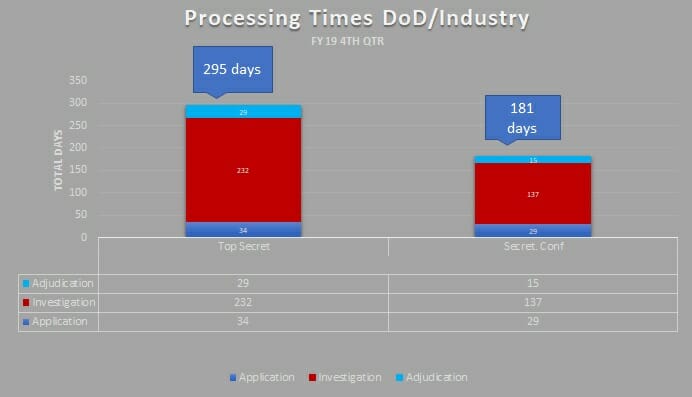After meeting its goal to cut the size of the security clearance backlog in half, the Defense Counterintelligence and Security Agency has finally made progress on the goal that has the most direct impact on the cleared workforce – security clearance processing times. In figures released at today’s National Industrial Security Program Policy Advisory Committee (NISPPAC) meeting, DCSA noted a dramatic drop in security clearance processing times as of FY 2019 Q4 – 295 days for Top Secret clearances (down from a high that reached over 500 days), and 181 days for Secret security clearances, down from over 300 days. These are DoD/Industry only numbers, and also represent the fastest 90% of all clearances. That means there are still outliers, but security clearance processing times are finally starting to move in the right direction – and in a significant way.

Acting DCSA Charles Phalen also noted the state of the backlog of pending cases – the figure is now at 267,000 cases. Phalen and Gary Reid, Director of Defense Intelligence, Counterintelligence, Law Enforcement & Security, Office of the Under Secretary of Defense for Intelligence, spent time introducing NISPPAC attendees to their organizations, and the new mission of personnel vetting and counterintelligence that includes 105 agencies, now operating under the DoD umbrella.
“What do we look like, what is our focus? It boils down to two questions – one is, do we trust the people that are coming into the government, how do we vet those individuals and make sure they can be trusted? Second thing is, industry, cleared industry – how do we protect that critical technology?” said Phalen. “Everything we do in this organization [DCSA] asks one of those two questions, and frequently, it asks both of those questions.”
Process Improvements = Better Processing Times
For months, the National Background Investigations Bureau (NBIB), now DCSA, has argued that the process improvements it was putting in place would eventually begin to move the needle on security clearance processing times. Increasing the inventory moving into continuous vetting helped to reduce the size of the backlog, but processing time improvements stalled. Across all four quarters of 2019, security clearance processing times dropped, specifically for Top Secret security clearance determinations.
When asked for the reason behind the significant reductions, DCSA representatives once again pointed to those process improvements – dramatic increases in the number of background investigators, improving technology, and video teleconferencing solutions for background investigations. All of these were initiatives that begun under NBIB – rather than inheriting a sizable backlog, it looks like the DoD inherited a program well on its way toward providing a 21st century solution to the personnel vetting problem.




